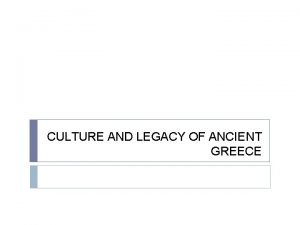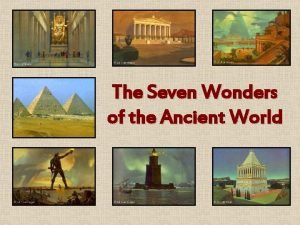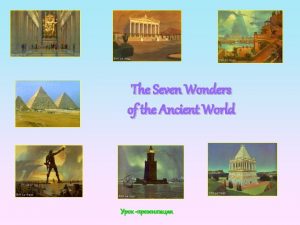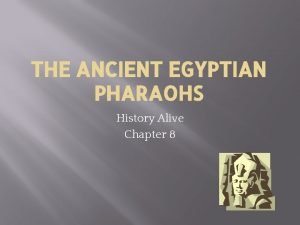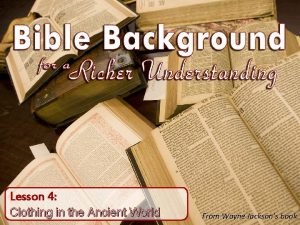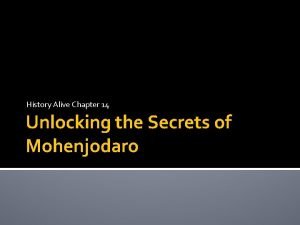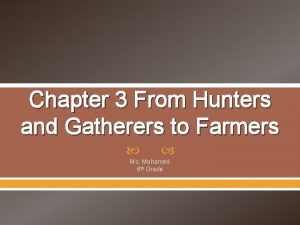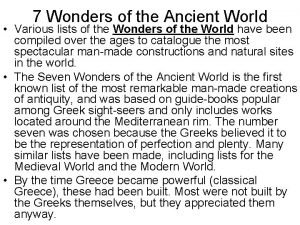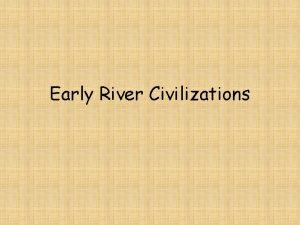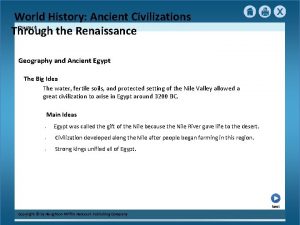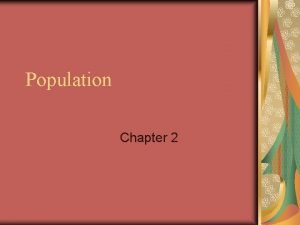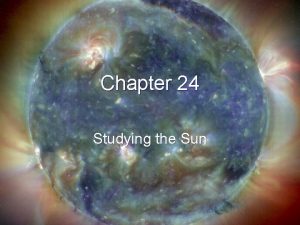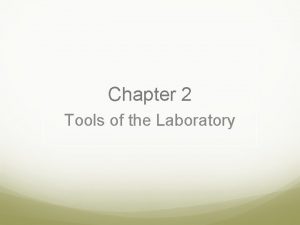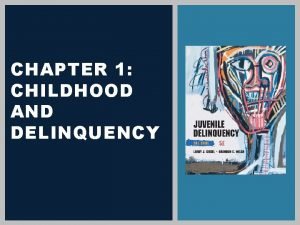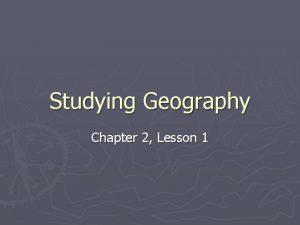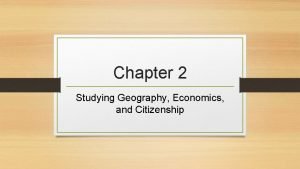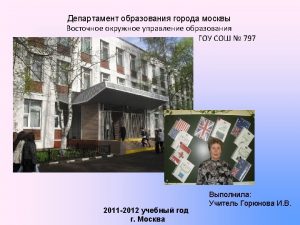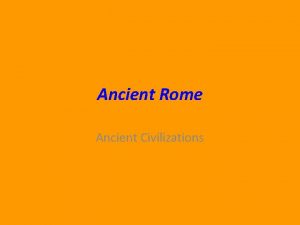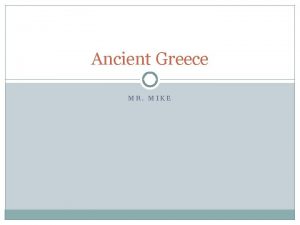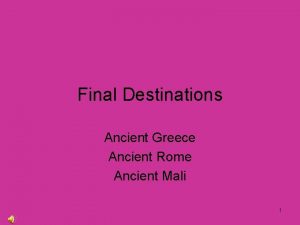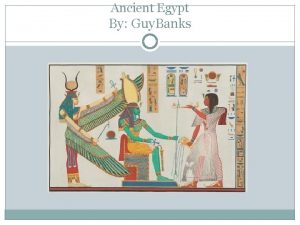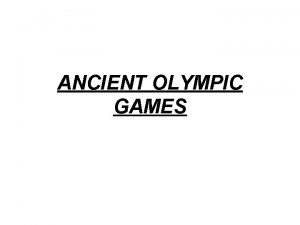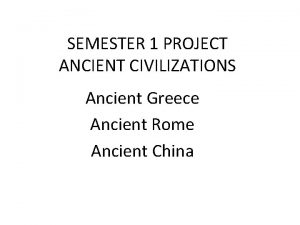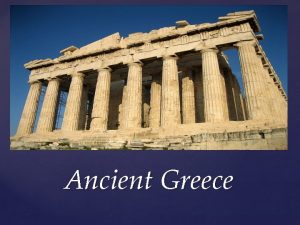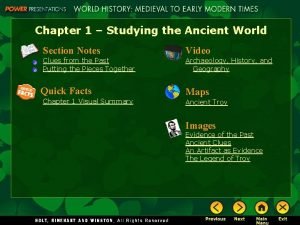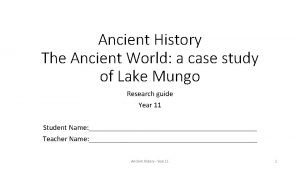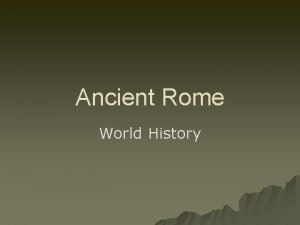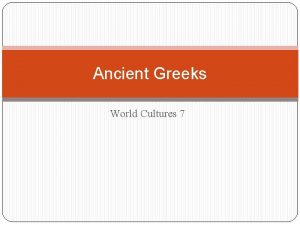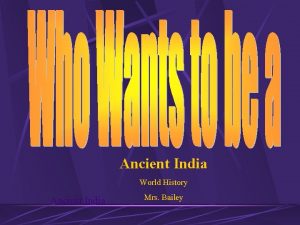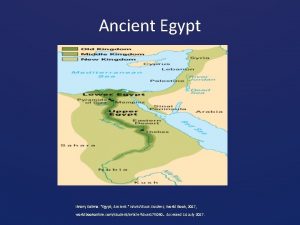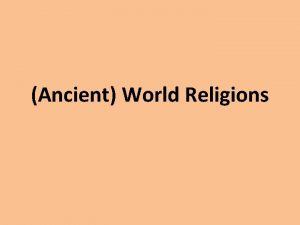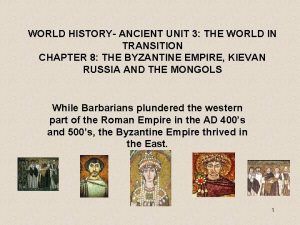1 Studying the Ancient World 1 Studying the









































































- Slides: 73

1. Studying the Ancient World

1. Studying the Ancient World C 1 S 1 Clues from the Past Main Ideas 1. Historians and archaeologists look for clues in written records and artifacts. 2. Other sources of clues include legends and luck. The Big Idea Historians and archaeologists study fossils, artifacts, and written records to learn about the past.

1. Studying the Ancient World C 1 S 2 Putting the Pieces Together Main Ideas 1. Historians and archaeologists look for clues in written records and artifacts. 2. Other sources of clues include legends and luck. The Big Idea Historians and archaeologists study fossils, artifacts, and written records to learn about the past.

2. The Fall of Rome (117 – 1453)

2. The Fall of Rome (117 – 1453) C 2 S 1 The Roman Empire Main Ideas 1. Leadership and laws helped the Romans in building the empire. 2. Roman advancements in engineering, architecture, art, and philosophy helped. 3. Christianity spread quickly throughout the Roman world. The Big Idea The Romans made great advances in many fields that helped keep their empire strong.

2. The Fall of Rome (117 – 1453) C 2 S 2 Fall of the Western Roman Empire Main Ideas 1. Many problems threatened the Roman Empire, leading one emperor to divide it in half. 2. Barbarians invaded Rome in the 300 s and 400 s. 3. Many factors contributed to Rome’s fall. The Big Idea Problems from both inside and outside caused the Roman Empire to split and the western half to collapse.

2. The Fall of Rome (117 – 1453) C 2 S 3 The Byzantine Empire Main Ideas 1. Eastern emperors ruled from Constantinople and tried but failed to reunite the whole Roman Empire. 2. The people of the eastern empire created a new society that was very different from society in the west. 3. Byzantine Christianity was different from religion in the west. The Big Idea The Roman Empire split into two parts, and the eastern Roman Empire prospered for hundreds of years after the western empire fell.

3. The Rise of Islam (AD 550 -650)

3. The Rise of Islam (AD 550 -650) C 3 S 1 Geography and Life in Arabia Main Ideas 1. Arabia is mostly a desert land. 2. Two ways of life – nomadic and sedentary – developed in the desert. The Big Idea Life in Arabia was influenced by the harsh desert climate of the region.

3. The Rise of Islam (AD 550 -650) C 3 S 2 Origins of Islam Main Ideas 1. Muhammad became a prophet and introduced a religion called Islam in Arabia. 2. Muhammad’s teachings had similarities to Judaism and Christianity, but they also presented new ideas. 3. Islam spread in Arabia after being rejected at first. The Big Idea Muhammad, a merchant from Mecca, introduced a major world religion called Islam.

3. The Rise of Islam (AD 550 -650) C 3 S 3 Islamic Beliefs and Practices Main Ideas 1. The Qur’an guides Muslims’ lives. 2. The Sunnah tells Muslims of important duties expected of them. 3. Islamic law is based on the Qur’an and the Sunnah. The Big Idea Sacred texts called the Qur’an and the Sunnah guide Muslims in their religion, daily life, and laws.

4. The Spread of Islam (634 – 1650)

4. The Spread of Islam (634 – 1650) C 4 S 1 Early Expansion Main Ideas 1. Muslim armies conquered many lands into which Islam slowly spread. 2. Trade helped Islam spread into new areas. 3. A mix of cultures was one result of Islam’s spread. 4. Islamic influence encourage the growth of cities. The Big Idea Conquest and trade led to the spread of Islam, the blending of cultures, and the growth of cities.

4. The Spread of Islam (634 – 1650) C 4 S 2 Muslim Empires Main Ideas 1. The Ottoman Empire covered a large area in eastern Europe. 2. The Safavid Empire blended Persian cultural traditions with Shia Islam. 3. The Mughal Empire in India left an impressive cultural heritage. The Big Idea After the early spread of Islam, three large Islamic empires formed – the Ottoman, Safavid, and Mughal.

4. The Spread of Islam (634 – 1650) C 4 S 3 Muslim Empires Main Ideas 1. Muslim scholars made advances in various fields of science and philosophy. 2. Islam influenced styles of literature and the arts. The Big Idea Muslim scholars and artists made contributions to science, art, and literature.

5. Early West African Societies (3000 BC – AD 300)

5. Early West African Societies (3000 BC – AD 300) C 5 S 1 Geography of Africa Main Ideas 1. The landforms, water, climate, and plant life affected history in West Africa. 2. West Africa’s resources included farmland, gold, and salt. The Big Idea West Africa has varied environments and valuable resources.

5. Early West African Societies (3000 BC – AD 300) C 5 S 2 Early Culture and Trade Main Ideas 1. Family and religion influenced daily life in early West African society. 2. Iron technology changed life in West Africa. 3. Trade shaped the history of West Africa. The Big Idea Family ties, religion, iron technology, and trade all contributed to the growth of West African societies.

6. West African Empires (1000 – 1600)

6. West African Empires (1000 – 1600) C 6 S 1 Empire of Ghana Main Ideas 1. Ghana controlled trade and became wealthy. 2. Through its control of trade, Ghana built an empire. 3. Ghana’s decline was caused by attacking invaders, overgrazing, and the loss of trade. The Big Idea The rulers of Ghana built an empire by controlling the salt and gold trade.

6. West African Empires (1000 – 1600) C 6 S 2 Empire of Ghana Main Ideas 1. A ruler named Sundiata made Mali into an empire. 2. Mali reached its height under the ruler Mansa Musa. 3. Mail fell to invaders in the late 1400 s. The Big Idea The wealthy and powerful Mali Empire ruled West Africa after the fall of Ghana.

6. West African Empires (1000 – 1600) C 6 S 3 Empire of Songhai Main Ideas 1. The Songhai built a new empire in West Africa. 2. Askia the Great ruled Songhai as an Islamic empire. 3. Songhai fell to Moroccan invaders, ending the great era of West African empires. The Big Idea The Songhai Empire strengthened Islam in West Africa.

6. West African Empires (1000 – 1600) C 6 S 4 Historical and Artistic Traditions Main Ideas 1. Storytellers helped maintain the oral history of the cultures of West Africa. 2. Visitors to West Africa from other lands wrote histories and descriptions of what they saw there. 3. Traditionally, West Africans have valued the arts. The Big Idea Because the people of West Africa did not have a written language, their culture has been passed down through oral history, writings by other people, and the arts.

7. China (589 – 1450)

7. China (589 – 1450) C 7 S 1 China Reunifies Main Ideas 1. The Period of Disunion was a time of war and disorder that followed the end of the Han dynasty. 2. China was reunified under the Sui, Tang, and Song dynasties. 3. The Age of Buddhism saw major religious changes in China. The Big Idea The Period of Disunion was followed by reunification by rulers of the Sui, Tang, and Song dynasties.

7. China (589 – 1450) C 7 S 2 Tang and Song Achievements Main Ideas 1. Advances in agriculture led to increased trade and population growth. 2. Cities and trade grew during the Tang and Song dynasties. 3. The Tang and Song dynasties produced fine arts and inventions. The Big Idea The Tang and Song dynasties were periods of economic, cultural, and technological accomplishments.

7. China (589 – 1450) C 7 S 3 Confucianism and Government Main Ideas 1. Confucianism underwent changes and influenced Chinese government. 2. Scholar-officials ran China’s government during the Song dynasty. The Big Idea Confucian thought influenced the Song government.

7. China (589 – 1450) C 7 S 4 The Yuan and Ming Dynasties Main Ideas 1. The Mongol Empire included China, and the Mongols ruled China as the Yuan dynasty. 2. The Ming dynasty was a time of stability and prosperity. 3. China under the Ming saw great changes in its government and relations with other countries. The Big Idea The Chinese were ruled by foreigners during the Yuan dynasty, but they threw off Mongol rule and prospered during the Ming dynasty.

8. Japan (550 -1868)

8. Japan (550 -1868) C 8 S 1 Geography and Early Japan Main Ideas 1. Geography shaped life in Japan. 2. Early Japanese society was organized in clans, which came to be ruled by an emperor. 3. Japan learned about language, society, and government from China and Korea. The Big Idea Japan’s early societies were both isolated from and influenced by China and Korea.

8. Japan (550 -1868) C 8 S 2 Art and Culture in Heian Main Ideas 1. Japanese nobles created great art in their court at Heian. 2. Buddhism changed in Japan during the Heian period. The Big Idea Japanese culture experienced a golden age during the Heian period of the 800 s to the 1100 s.

8. Japan (550 -1868) C 8 S 3 Growth of a Military Society Main Ideas 1. Samurai and shoguns took over Japan as emperors lost influence. 2. Samurai warriors lived honorably. 3. Order broke down when the power of the shoguns was challenged by invaders and rebellions. 4. Strong leaders took over and reunified Japan. The Big Idea Japan developed a military society led by generals called shoguns.

9. The Early Middle Ages (400 – 1200)

9. The Early Middle Ages (400 – 1200) C 9 S 1 Growth of a Military Society Main Ideas 1. The physical features of Europe vary widely from region to region. 2. Geography has shaped life in Europe, including where and how people live. The Big Idea Because Europe has many types of landforms and climates, different ways of life have developed there.

9. The Early Middle Ages (400 – 1200) C 9 S 2 Europe after the Fall of Rome Main Ideas 1. Christianity spread to northern Europe through the work of missionaries and monks. 2. The Franks, led by Charlemagne, created a huge Christian empire and brought together scholars from around Europe. 3. Invaders threatened much of Europe in the 700 s and 800 s. The Big Idea Despite the efforts of Christians to maintain order, Europe was a dangerous place after the fall of Rome.

9. The Early Middle Ages (400 – 1200) C 9 S 3 Feudalism and Manor Life Main Ideas 1. Feudalism governed how knights and nobles dealt with each other. 2. Feudalism spread through much of Europe. 3. The manor system dominated Europe’s economy. 4. Towns and trade grew and helped end the feudal system. The Big Idea A complex web of duties and obligations governed relationships between people in the Middle Ages.

9. The Early Middle Ages (400 – 1200) C 9 S 4 Feudal Societies Main Ideas 1. Feudal societies shared common elements in Europe and Japan. 2. Europe and Japan differed in their cultural elements such as religion and art. The Big Idea Although the feudal systems of Europe and Japan were similar, their cultures were very different.

10. The Later Middle Ages (1000 – 1500).

10. The Later Middle Ages (1000 – 1500) C 10 S 1 Popes and Kings Main Ideas 1. Popes and kings ruled Europe as spiritual and political leaders. 2. Popes fought for power, leading to a permanent split within the church. 3. Kings and popes clashed over some issues. The Big Idea Popes and kings dominated European society in the Middle Ages.

10. The Later Middle Ages (1000 – 1500) C 10 S 2 The Crusades Main Ideas 1. The pope called on Crusaders to invade the Holy Land. 2. Despite some initial success, the later Crusades failed. 3. The Crusades changed Europe forever. The Big Idea The Christian and Muslim cultures fought over holy sites during a series of medieval wars.

10. The Later Middle Ages (1000 – 1500) C 10 S 3 Christianity and Medieval Society Main Ideas 1. The Christian Church shaped society and politics in medieval Europe. 2. Orders of monks and friars did not like the church’s political nature. 3. Church leaders helped build the first universities in Europe. 4. The church influenced the arts in medieval Europe. The Big Idea The Christian Church was central to life in the Middle Ages.

10. The Later Middle Ages (1000 – 1500) C 10 S 4 Political and Social Change Main Ideas 1. Magna Carta caused changes in England’s government and legal system. 2. The Hundred Years’ War led to political changes to England France. 3. The Black Death, which swept through Europe in the Middle Ages, led to social changes. The Big Idea Europe’s political and social systems underwent great changes in the late Middle Ages.

10. The Later Middle Ages (1000 – 1500) C 10 S 5 Challenges to Church Authority Main Ideas 1. The church reacted to challengers by punishing people who opposed its teachings. 2. Christians fought Moors in Spain and Portugal in an effort to drive all Muslims out of Europe. 3. Jews faced discrimination across Europe in the Middle Ages. The Big Idea In the Middle Ages, the Christian Church dealt harshly with people who did not respect its authority.

11. The Renaissance (1271 – 1600)

11. The Renaissance (1271 – 1600) C 11 S 1 Origins of the Renaissance Main Ideas 1. European trade with Asia increased in the 1300 s. 2. Trade cities in Italy grew wealthy and competed against each other. 3. As Florence became a center for arts and learning, the Renaissance began. The Big Idea The growth of wealthy trading cities in Italy led to a new era called the Renaissance.

11. The Renaissance (1271 – 1600) C 11 S 2 The Italian Renaissance Main Ideas 1. During the Italian Renaissance, people found new ways to see the world. 2. Italian writers contributed great works of literature. 3. Italian art and artists were among the finest in the world. 4. Science and education made advances during this time. The Big Idea New ways of thinking created a rebirth of the arts and learning in Italy.

11. The Renaissance (1271 – 1600) C 11 S 3 The Renaissance beyond Italy Main Ideas 1. Paper, printing, and new universities led to the spread of new ideas. 2. The ideas of the Northern Renaissance differed from those of the Italian Renaissance. 3. Literature beyond Italy also thrived in the Renaissance. The Big Idea The Renaissance spread far beyond Italy and changed in the process.

12. The Reformation of Christianity (1492 – 1650)

12. The Reformation of Christianity (1492 – 1650) C 12 S 1 The Protestant Reformation Main Ideas 1. The Catholic Church faced challengers who were upset with the behavior of Catholic clergy and with church practices. 2. Martin Luther urged reform in the Catholic Church, but he eventually broke away from the church. 3. Other reformers built on the ideas of early reformers to create their own churches. The Big Idea Unsatisfied with the Roman Catholic Church, religious reformers broke away to form their own churches.

12. The Reformation of Christianity (1492 – 1650) C 12 S 2 The Catholic Reformation Main Ideas 1. The influence of the church created a Catholic culture in Spain. 2. Catholic reforms emerged in response to the Reformation. 3. Missionaries worked to spread Catholic teachings. The Big Idea Catholic leaders worked to reform the Catholic Church and spread Catholic teachings.

12. The Reformation of Christianity (1492 – 1650) C 12 S 3 Effects of the Reformation Main Ideas 1. Religious division occurred within Europe and the Americas. 2. Religious wars broke out between Protestants and Catholics. 3. Social changes were a result of the Reformation. The Big Idea The Reformation changed religion in Europe and led to political and cultural conflicts.

13. The Scientific Revolution (1525 – 1725)

13. The Scientific Revolution (1525 – 1725) C 13 S 1 A New View of the World Main Ideas 1. The Scientific Revolution marked the birth of modern science. 2. The roots of the Scientific Revolution can be traced to ancient Greece, the Muslim world, and Europe. The Big Idea Europeans drew on earlier ideas to develop a new way of gaining knowledge about the natural world.

13. The Scientific Revolution (1525 – 1725) C 13 S 2 Discoveries and Inventions Main Ideas 1. The discovery of the Americas led scholars to doubt ancient Greek ideas. 2. Advances in astronomy were key events of the Scientific Revolution. 3. Sir Isaac Newton developed laws that explained much of the natural world. 4. New inventions helped scientists study the natural world. The Big Idea During the Scientific Revolution, new ideas and inventions changed the nature of knowledge.

13. The Scientific Revolution (1525 – 1725) C 13 S 3 Science and Society Main Ideas 1. The ideas of Francis Bacon and Rene Descartes helped to clarify the scientific method. 2. Science influenced new ideas about government. 3. Science and religion developed a sometimes uneasy relationship. The Big Idea The Scientific Revolution led to the establishment of science as a method of learning, new ideas about government, and conflict with religious authorities.

14. The Early Americas (12, 000 BC – AD 1000)

14. The Early Americas (12, 000 BC – AD 1000) C 14 S 1 Geography and Early Cultures Main Ideas 1. The geography of the Americas is varied with a wide range of landforms. 2. The first people to arrive in the Americas were huntergatherers. 3. The development of farming led to early settlements in the Americas. The Big Idea The landforms and climate of the Americas affected farming and the development of early cultures.

14. The Early Americas (12, 000 BC – AD 1000) C 14 S 2 The Maya Main Ideas 1. Geography affected early Maya civilization. 2. The Maya Classic Age was characterized by great cities, trade, and warfare. 3. Maya civilization declined and historians have several theories as to why. The Big Idea Maya civilization was characterized by great cities, trade, and warfare, but it disappeared for reasons that are still unclear.

14. The Early Americas (12, 000 BC – AD 1000) C 14 S 2 The Maya Main Ideas 1. Roles in Maya society were based on a complex class structure. 2. Religion in Maya society was often bloody. 3. The Maya made achievements in art, science, math, and writing. The Big Idea People played different roles in Maya society, but together they made great achievements in art, science, math, and writing.

14. The Early Americas (12, 000 BC – AD 1000) C 14 S 3 Maya Life and Society Main Ideas 1. Roles in Maya society were based on a complex class structure. 2. Religion in Maya society was often bloody. 3. The Maya made achievements in art, science, math, and writing. The Big Idea People played different roles in Maya society, but together they made great achievements in art, science, math, and writing.

15. The Aztec and Inca Empires (1325 – 1537)

15. The Aztec and Inca Empires (1325 – 1537) C 15 S 1 The Aztec Empire Main Ideas 1. The Aztecs built an empire through warfare and trade and created an impressive capital city in Mesoamerica. 2. Hernan Cortes conquered the Aztec Empire. The Big Idea The Aztecs built a great empire in central Mexico but were conquered by the Spanish in 1521.

15. The Aztec and Inca Empires (1325 – 1537) C 15 S 2 Aztec Life and Society Main Ideas 1. Aztec society was divided by social roles and by class. 2. Aztec religion required human sacrifice for keeping the gods happy. 3. The Aztecs had many achievements in science, art, and language. The Big Idea The Aztecs developed complex social, religious, artistic, and scientific systems in their empire.

15. The Aztec and Inca Empires (1325 – 1537) C 15 S 3 The Inca Empire Main Ideas 1. The rise of the Inca Empire was due to conquest and the achievements of the Inca people. 2. Pizarro conquered the Incas and took control of the region. The Big Idea The Incas built a huge empire in South America, but they were conquered by the Spanish.

15. The Aztec and Inca Empires (1325 – 1537) C 15 S 4 Inca Life and Society Main Ideas 1. For the Incas, position in society affected daily life. 2. The Incas made great achievements in building, art, and oral literature. The Big Idea Many kinds of people made up Inca society in an empire known for grand architecture and complex oral literature.

16. The Age of Exploration (1400 – 1650).

16. The Age of Exploration (1400 – 1650) C 16 S 1 Great Voyages of Discovery Main Ideas 1. Europeans had a desire and opportunity to explore. 2. Portuguese and Spanish explorations led to discoveries of new trade routes, lands, and people. 3. English and French explorers found land in North America. 4. A new European worldview developed because of the discoveries. The Big Idea European explorers made discoveries that brought knowledge, wealth, and influence to their countries.

16. The Age of Exploration (1400 – 1650) C 16 S 2 The Columbian Exchange Main Ideas 1. Plants and animals were exchanged among Europe, Asia, Africa, and the Americas. 2. Culture and technology changed as ideas were exchanged between Europe and the Americas. 3. Society and the economy changed in Europe and the Americas. The Big Idea The exchange of plants, animals, ideas, and technology between the Old World and the New World brought many changes all over the world.

16. The Age of Exploration (1400 – 1650) C 16 S 3 Origins of Capitalism Main Ideas 1. A new economic system called mercantilism emerged. 2. New trading patterns developed in the 1600 s and 1700 s. 3. Power in Europe shifted as a result of new trade routes, banking, and increased manufacturing. 4. Market economies changed business in Europe. The Big Idea Changes in international trading and marketing patterns influenced the development of a new economic system called capitalism.

17. Enlightenment and Revolution (1642 – 1800)

17. Enlightenment and Revolution (1642 – 1800) C 17 S 1 Ideas of the Enlightenment Main Ideas 1. The Enlightenment was also called the Age of Reason. 2. The Enlightenment’s roots can be traced back to earlier ideas. 3. New ideas came mainly from French and British thinkers. The Big Idea Enlightenment thinkers built on ideas from earlier movements to emphasize the importance of reason.

17. Enlightenment and Revolution (1642 – 1800) C 17 S 2 New Views on Government Main Ideas 1. The Enlightenment influenced some monarchies. 2. Enlightenment thinkers helped the growth of democratic ideas. 3. In America, the Enlightenment inspired a struggle for independence. The Big Idea Enlightenment ideas influenced the growth of democratic governments in Europe and America.

17. Enlightenment and Revolution (1642 – 1800) C 17 S 3 The Age of Revolution Main Ideas 1. Revolution and reform changed the governments of England. 2. Enlightenment ideas led to democracy in America. 3. The French Revolution caused major changes in France’s government. The Big Idea Revolutions changed the governments of Britain, the American colonies, and France.
 Culture or way of living station 1
Culture or way of living station 1 Ancient time ancient means of communication pictures
Ancient time ancient means of communication pictures Ancient india vs ancient china
Ancient india vs ancient china Seven woders of the world
Seven woders of the world 7 ancient wonders of the world
7 ancient wonders of the world Ancient wonders of the world map
Ancient wonders of the world map History alive chapter 8
History alive chapter 8 Clothing in the ancient world
Clothing in the ancient world History alive chapter 14
History alive chapter 14 From hunters and gatherers to farmers chapter 3 answers
From hunters and gatherers to farmers chapter 3 answers 7 wonders of the ancient world names
7 wonders of the ancient world names 7 wonders of the ancient world map
7 wonders of the ancient world map Tigris euphrates and nile river
Tigris euphrates and nile river World history ancient civilizations through the renaissance
World history ancient civilizations through the renaissance Hát kết hợp bộ gõ cơ thể
Hát kết hợp bộ gõ cơ thể Ng-html
Ng-html Bổ thể
Bổ thể Tỉ lệ cơ thể trẻ em
Tỉ lệ cơ thể trẻ em Voi kéo gỗ như thế nào
Voi kéo gỗ như thế nào Tư thế worms-breton
Tư thế worms-breton Hát lên người ơi
Hát lên người ơi Các môn thể thao bắt đầu bằng tiếng chạy
Các môn thể thao bắt đầu bằng tiếng chạy Thế nào là hệ số cao nhất
Thế nào là hệ số cao nhất Các châu lục và đại dương trên thế giới
Các châu lục và đại dương trên thế giới Công của trọng lực
Công của trọng lực Trời xanh đây là của chúng ta thể thơ
Trời xanh đây là của chúng ta thể thơ Mật thư anh em như thể tay chân
Mật thư anh em như thể tay chân Phép trừ bù
Phép trừ bù độ dài liên kết
độ dài liên kết Các châu lục và đại dương trên thế giới
Các châu lục và đại dương trên thế giới Thơ thất ngôn tứ tuyệt đường luật
Thơ thất ngôn tứ tuyệt đường luật Quá trình desamine hóa có thể tạo ra
Quá trình desamine hóa có thể tạo ra Một số thể thơ truyền thống
Một số thể thơ truyền thống Cái miệng bé xinh thế chỉ nói điều hay thôi
Cái miệng bé xinh thế chỉ nói điều hay thôi Vẽ hình chiếu vuông góc của vật thể sau
Vẽ hình chiếu vuông góc của vật thể sau Thế nào là sự mỏi cơ
Thế nào là sự mỏi cơ đặc điểm cơ thể của người tối cổ
đặc điểm cơ thể của người tối cổ Thứ tự các dấu thăng giáng ở hóa biểu
Thứ tự các dấu thăng giáng ở hóa biểu Vẽ hình chiếu đứng bằng cạnh của vật thể
Vẽ hình chiếu đứng bằng cạnh của vật thể Vẽ hình chiếu vuông góc của vật thể sau
Vẽ hình chiếu vuông góc của vật thể sau Thẻ vin
Thẻ vin đại từ thay thế
đại từ thay thế điện thế nghỉ
điện thế nghỉ Tư thế ngồi viết
Tư thế ngồi viết Diễn thế sinh thái là
Diễn thế sinh thái là Dot
Dot Số.nguyên tố
Số.nguyên tố Tư thế ngồi viết
Tư thế ngồi viết Lời thề hippocrates
Lời thề hippocrates Thiếu nhi thế giới liên hoan
Thiếu nhi thế giới liên hoan ưu thế lai là gì
ưu thế lai là gì Hươu thường đẻ mỗi lứa mấy con
Hươu thường đẻ mỗi lứa mấy con Sự nuôi và dạy con của hươu
Sự nuôi và dạy con của hươu Sơ đồ cơ thể người
Sơ đồ cơ thể người Từ ngữ thể hiện lòng nhân hậu
Từ ngữ thể hiện lòng nhân hậu Thế nào là mạng điện lắp đặt kiểu nổi
Thế nào là mạng điện lắp đặt kiểu nổi Researchers who are studying a new shampoo
Researchers who are studying a new shampoo Demographic transition def
Demographic transition def Job evaluation point method example
Job evaluation point method example Dua for memorising for exams
Dua for memorising for exams Studying in sweden as an eu citizen
Studying in sweden as an eu citizen Studying our living planet
Studying our living planet A student is studying the ecology of a playa lake
A student is studying the ecology of a playa lake Chapter 24 studying the sun
Chapter 24 studying the sun The five i's of studying microorganisms
The five i's of studying microorganisms What do global ecologists study
What do global ecologists study Juvenile delinquency objectives
Juvenile delinquency objectives When criticizing functional objects
When criticizing functional objects Are arthropods protostomes or deuterostomes
Are arthropods protostomes or deuterostomes Guided reading lesson 1 studying geography answer key
Guided reading lesson 1 studying geography answer key Module 11 studying the brain
Module 11 studying the brain Chapter 2 lesson 1 studying geography
Chapter 2 lesson 1 studying geography Benefits of studying in a quiet place
Benefits of studying in a quiet place Imagine you are studying english
Imagine you are studying english
